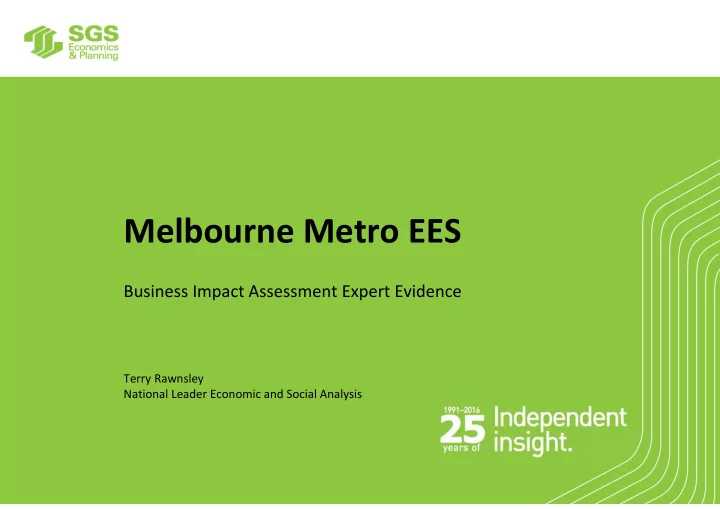

Melbourne Metro EES Business Impact Assessment Expert Evidence Terry Rawnsley National Leader Economic and Social Analysis
Outline • Scoping requirments • Key Business Impact Assessment inputs • Key issues identified in the Business Impact Assessment • Summary of estimated impact • Summary of key issues raised in the submissions. The statement of evidence details all of the issues raised. • EES EPRs • Suggested changes to EPRs 2
Scoping Requirements PAGE 3
Key inputs • Precinct Context and Construction Impact. 4
Key inputs • Melbourne Metro Rail Project Transport Impact Assessment (April 2016) (Technical Appendix A) . 5
Key inputs • Melbourne Metro Rail Project Noise and Vibration Impact Assessment (April 2016) (Technical Appendix I) . 6
Key inputs • Other inputs to understand the impacts 7
Key inputs • Other inputs to understand the impacts AM Peak Lunch Time 8
Impact Assessment • For non ‐ acquired Retail and Food Services businesses Access Amenity Perception Pedestrian Flows Business Impacts 9
Previous projects • Victorian Comprehensive Cancer Centre (2012 – 2016) • Swanston Street Redevelopment (2012 – 2014) • Myer Emporium Development (2012 – 2014) • RMIT Swanston Academic Building (2010 – 2012) • RMIT Capital Works Program (2007 – 2016) • Tram Super Stops (2011 – 2012) • State Library of Victoria (six major stages 1986 – 2006) • Southern Cross Station (2002 – 2007) • Melbourne Central (2000 – 2003) • Fitzroy Gardens Storm Harvesting System (2013) 10
Previous projects • Tram Super Stops 2011 ‐ 2012 11
Previous projects • Tram Super Stops 2011 ‐ 2012 12
Previous projects Victorian Comprehensive Cancer Myer Emporium Development Centre (2012 – 2016) (2012 – 2014) Fitzroy Gardens Storm Harvesting System (2013) Southern Cross Station (2002 – 2007) 13
Key issues from BIA • Disruption to business activity from the acquisition or displacement of commercial land and businesses • Construction activity disrupting business operations, particularly for hospitals and research institutions with specialist and highly sensitive equipment • Construction activity adversely affecting the surrounding amenity disrupting business activity, particularly for retail, food and beverage and accommodation businesses • Construction activity impacting access to businesses thereby disrupting their trade, particularly impacting businesses that rely on passing trade 14
Summary of estimated impacts Acquisition / temporary Precincts Non ‐ acquisition impact Total Impact occupation impact ($m) % ($m) % ($m) % Tunnels ‐ 0.3 0.0% ‐ 12.4 ‐ 0.5% ‐ 12.7 ‐ 0.5% Western Portal ‐ 23.0 ‐ 34.3% 0 0.0% ‐ 23.0 ‐ 34.3% Arden Station ‐ 17.0 ‐ 24.3% ‐ 0.4 ‐ 0.6% ‐ 17.4 ‐ 24.9% Parkville Station ‐ 4.7 ‐ 0.3% ‐ 12.4 ‐ 0.8% ‐ 17.1 ‐ 1.1% CBD North Station ‐ 60.0 ‐ 6.5% ‐ 11.4 ‐ 1.2% ‐ 71.4 ‐ 7.7% CBD South Station ‐ 24.0 ‐ 3.3% ‐ 11.2 ‐ 1.5% ‐ 35.2 ‐ 4.8% Domain Station 0 0.0% ‐ 0.8 ‐ 1.1% ‐ 0.8 ‐ 1.1% Eastern Portal 0 0.0% ‐ 1.1 ‐ 4.4% ‐ 1.1 ‐ 4.4% Western Turnback 0 0.0% 0 0.0% 0 0.0% (West Footscray) 15
Key issues raised in submissions • Acquisition or displacement disrupting business operations • Access changes impacting business operations • Increased traffic and parking demand impacting access for staff, customers and deliveries/pick up • Amenity changes impacting business operations • Impacts to sensitive equipment and processes • Disruption to business activity from disruptions to utilities • Impact on events 16
Support Guidelines • Technical Note 045 provides guidelines for non ‐ acquired business (excluding health and education) which may be impacted by the project. • Prior to construction undertake interviews to better understand the likely impact on businesses. • Focused on engagement, communication and marketing for impacted businesses. • This would cover the vast bulk of impacts but may lack detail for unique impacts. PAGE 17
EPRs • The EPRs proposed in the exhibited EES would likely manage the majority of impacts from the Melbourne Metro Rail Project. BUT • They may not manage unique impacts AS • Business types and construction impacts varies across precincts • In reviewing other expert evidence statements, the majority of changes suggested involve adding detail to the existing EPRs to manage unique impacts PAGE 18
Refinements to EPRs • Current EPRs would manage the bulk of business impacts. • Refinements to the EPRs will provide a more detailed framework for managing the impacts for business types that are likely to be at risk of being impacted in a unique manner by the project. PAGE 19
Conclusion • The impacts of the project should be able to be managed to minimise the impact on the vast majority of businesses which may be adversely impacted. PAGE 20
Recommend
More recommend